Mar 27, 2008 | BEP, currency, legal
During a discussion of inexpensive solutions for ways to make authentication into government systems stronger and accessible for the public at a low cost, we were told that the mechanism selected had a version in Braille to allow participation by the blind. Because the program was sponsored by the Department of the Treasury, it was considered ironic that Treasury was concerned about this blind in this program but does not make that same consideration for our currency.
The issue with accessibility of currency has long been an issue, especially since the passages of the Americans with Disabilities Act (Public Law 101-336, signed by President George H.W. Bush). Unfortunately, the Bureau of Engraving and Printing has interpreted Title III (Public Accommodation) as not applying to US currency. Even as the BEP has added new security features and the look to our currency, no changes were made for the blind.
In 2002, the American Council of the Blind (ACB) brought a lawsuit against the Treasury Department demanding that US currency be designed to be accessible to visually impaired people. The court ruled in favor of the ACB complaint in 2006. Treasury was supposed to respond to the order in 30 days from the review. No public statement has been made by Treasury.
From the BEP’s founding in 1861 through the mid-1920s, the bureau had a history of frequently changing currency designs and even changed its size around the turn of the century. Beginning in the 1920s, currency design did not change until the mid 1990s when new security features had to be added curb counterfeit problems.
Advocacy groups continue to petition BEP to make the currency more accessible to the visually impaired. BEP has even been provided with studies of describing the features used by over 100 countries to include the visually impaired. The Reserve Bank of Australia has researched and developed the use of polymer notes with special security features with consideration for the visually impaired with great success.
Rather than implement one of existing technologies that are being used by over 100 countries and the European Union, BEP designers chose to increase the size of the “5” on the reverse of the new $5 note so that it would be visible to those with limited sight capabilities. Allegedly, the intaglio printing used on the note is supposed to help the blind. What the BEP does not mention is that once the note wears, the benefits of the intaglio printing disappear.
The BEP does not have the same design restrictions that is placed on the the US Mint (31 U.S.C. §5112). BEP can change the notes at any time for any reason. The only restriction on US currency is that the denominations must begin with one dollar (31 U.S.C. §5115(a)(2)). So why does BEP continue to discriminate against one class of Americans while continuing to producing an ugly product?
Mar 17, 2008 | BEP, currency
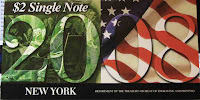 As time passes, I have found it is difficult to stick with buying only New York-related items for my New York collection. This time, I was helped by the Bureau of Engraving and Printing. After receiving an email alert, I was notified about the 2008 $2 Single Note folder.
As time passes, I have found it is difficult to stick with buying only New York-related items for my New York collection. This time, I was helped by the Bureau of Engraving and Printing. After receiving an email alert, I was notified about the 2008 $2 Single Note folder.
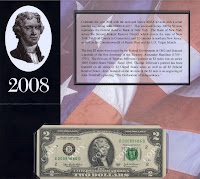 As a celebration of 2008, this offer was for an uncirculated Series 2003A $2 Federal Reserve Note with a serial number beginning with “2008xxxxD.” There is a total of 10,000 notes for this series. The BEP’s second offering in this series was for notes printed for the Federal Reserve Bank of New York. I thought this was a great addition to a New York collection, so I ordered three!
As a celebration of 2008, this offer was for an uncirculated Series 2003A $2 Federal Reserve Note with a serial number beginning with “2008xxxxD.” There is a total of 10,000 notes for this series. The BEP’s second offering in this series was for notes printed for the Federal Reserve Bank of New York. I thought this was a great addition to a New York collection, so I ordered three!
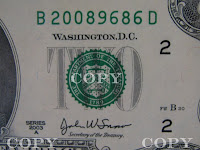 The three notes, consecutively numbered, came this week. I was surprised how simple, yet nice, the packaging was. The folder is made of a soft cardboard, 9½ inches wide by 5 inches high (10 inches when open) that is nicely printed and folded over. The notes are in archival sleeves with open tops. I am very happy with the purchase and the performance of the BEP with this transaction. The BEP’s customer service helped me resolve a minor issue (I ordered the wrong item) with no problems and then shipped the order promptly. Maybe the US Mint should hire the BEP as their customer service representatives.
The three notes, consecutively numbered, came this week. I was surprised how simple, yet nice, the packaging was. The folder is made of a soft cardboard, 9½ inches wide by 5 inches high (10 inches when open) that is nicely printed and folded over. The notes are in archival sleeves with open tops. I am very happy with the purchase and the performance of the BEP with this transaction. The BEP’s customer service helped me resolve a minor issue (I ordered the wrong item) with no problems and then shipped the order promptly. Maybe the US Mint should hire the BEP as their customer service representatives.
Pictures are of one of the folders received. The Notes have been marked as “copies” to prevent counterfeiting.
Mar 11, 2008 | BEP, currency
 This Thursday, March 13, the Bureau of Engraving and Printing will release the new colorized Series 2006 $5 Federal Reserve Note. A “first spend” ceremony is scheduled for 10:30am and will include Treasurer Anna Escobedo Cabral, Associate Director of Payment System for the Federal Reserve Board Michael Lambert, Pamela Gardiner of the BEP, and Deputy Assistant Director of the US Secret Service Michael Merritt (click here for biographies). A $5 note will be spent in the gift shop at Lincoln’s Cottage at the Soldiers’ Home.
This Thursday, March 13, the Bureau of Engraving and Printing will release the new colorized Series 2006 $5 Federal Reserve Note. A “first spend” ceremony is scheduled for 10:30am and will include Treasurer Anna Escobedo Cabral, Associate Director of Payment System for the Federal Reserve Board Michael Lambert, Pamela Gardiner of the BEP, and Deputy Assistant Director of the US Secret Service Michael Merritt (click here for biographies). A $5 note will be spent in the gift shop at Lincoln’s Cottage at the Soldiers’ Home.
 In addition to the first spend event, the Federal Reserve will be distributing 180 million, or $900 million, new notes to member banks. The Federal Reserve will distributed only the new $5 notes to the banks for 15 days where they will circulate along side the older notes. After the 15 days, viable older notes will be placed back into circulation.
In addition to the first spend event, the Federal Reserve will be distributing 180 million, or $900 million, new notes to member banks. The Federal Reserve will distributed only the new $5 notes to the banks for 15 days where they will circulate along side the older notes. After the 15 days, viable older notes will be placed back into circulation.
It is important to remember that the old notes will not be recalled or demonetized. They will circulate along side the new notes. Older notes will be replaced as they wear over time.
Images courtesy of the BEP
Jan 11, 2008 | BEP, coins, commemorative, currency, US Mint
Happy 2008 from me and your US Mint. For this year, I will continue to write about what interests me and the US Mint is trying to adjust to an every increasing set of product offerings. I also want to give a shout out to the Bureau of Engraving and Printing for jumping on the new product bandwagon. So let’s first take look at the Mint.
With a price increase of $2, the US Mint began sales of the American Silver Eagle Proof coin on January 3. US law prevents the US Mint cannot from selling or distributing coins with a future date, but it does not prevent them from striking the coins in preparation. So these coins are being shipped as they are sold. I believe that is the earliest in the year that the Mint has delivered a current year coin.
You can order the Bald Eagle Commemorative coins beginning on January 15. The Bald Eagle Commemorative will have three different designs on a $5 gold coin, silver dollar, and clad half-dollar. Coins will be available as Proof and Uncirculated coins that can be purchased individually, as a three coin proof set, a “Young Collector’s Set” with an uncirculated half-dollar and other educational material, and a coin & medal set featuring an uncirculated silver dollar and a bronze Bald Eagle Medal from the National Wildlife Refuge System Centennial Medal Series. See the Mint’s announcement for complete list of products, mintage limits, and prices.
Sales of bags and rolls of 2008 Kennedy Half-Dollars and Sacagawea Dollars will begin on January 17. These coins will not see circulation because there is no demand for them. But since the Mint is legally required to strike these coins, they will be offered to collectors.
Sales of the 50 State Quarters usually begins earlier than other proof sets. So get ready for the last of the 50 state proof coins on January 24. The program has been extended one year to include the District of Columbia and the five territories of the United States.
Not to be out done, the BEP is selling the second issue of the Americana Series with the release of the intaglio print for the 53rd Florida United Numismatics (FUN) show in Orlando this weekend.
Also released on January 10 are the 2004 $20 Single Note for the federal reserve districs of Atlanta, Boston, New York, and Philadelphia. The notes in this set are those with the lowest possible serial numbers that are packaged in an archival sleve placed in a folder representing the federal reserve district. Each folder is $45 and the entire 12 note series can be bought as a subscription for $479.95.
Taking their cue from their friends at the US Mint, BEP “is excited to celebrate the year 2008 by offering the 2008 $2 Single Note.” This product is a Series 2003A Federal Reserve Note from the Atlanta federal reserve district with the serial number beginning with “2008.” Since the serial number is eight digits followed by the letter designating the federal reserve district, there will only be 10,000 notes for this product (20080000D through 20089999D). Each folder will cost $7.95. There is no indication that this type of collectible will be extended to other federal reserve districts.
Maybe the other notes whose serial number beginning with 2008 will be used for BEP’s Prosperity Line collection. The Prosperity Note Line features serial numbers beginning with 168 or 8888 which are significant in Chinese symbolism. On January 17, BEP will release the $2 Double Lucky Money Set. The set features two uncirculated $2 Federal Reserve notes. The serial number of one note will begin with “8888,” to symbolize good fortune, and “2008,” to commemorate the New Year. Both notes will feature serial numbers with matching last four digits. When released, the set will cost $48.88.
All this being introduced in January—with eleven months to go! Happy Collecting!
Nov 13, 2007 | ANA, Baltimore, BEP, coins, currency, shows
As I take my midday lunch break on Tuesday, I made sure that I posted my Friday day off on my company’s internal calendar and started to think about the Whitman Baltimore show. So I started to gather my email of announcements and news to bring together the scope of Whitman’s effort going into this show.
I previously wrote about the American Numismatic Association offering classes on Understanding Die Varieties and Coin Collecting 101. This is a great step for the ANA expand its education mission beyond its conventions and the summer seminars.
The Bureau of Engraving and Printing announced their 2008 Intaglio Print Subscription Program called the “Americana Series.” The first issue will be at the Baltimore Show. BEP will have a press on site in Baltimore. BEP announced that they will also display, for the first time ever, a sheet of the new $5 Federal Reserve Note as well as its “Billion Dollar Exhibit.”
David Lange announced on the Collectors’ Society Boards that he will presenting a slide show about coin boards of the 1930s-40s. This will be based on his book Coin Collecting Boards of the 1930s & 1940s. According to Dave, the program will be on Saturday at 2pm in Room 301. There will be a free drawing in which three attendees will each win a vintage coin board after the program.
With over 4,000 lots and a full currency session, Bowers and Merena Auctions will be holding their largest auction in company history. There are a number of interesting items for the rare coin and currency collector. See their online catalog for the lots that will be auctioned.
There will be coin grading by NGC, PCGS, ANACS, and ICG. The ANA and the folks from Florida United Numismatists will also be present.
It appears as if Whitman is looking to challenge FUN’s proclamation of being the “Largest Coin Show in America.” The only thing Baltimore is missing are the exhibits—maybe this is something they can include next year. But if it is Whitman’s goal to make their Baltimore show larger than FUN, I am sure those of us who live closer to Baltimore appreciates the opportunity to attend a premier show.
Sep 20, 2007 | BEP, currency
Today, the Bureau of Engraving and Printing released a web-based video starring BEP Director Larry Felix, Treasurer Anna Escobedo Cabral, and Assistant Federal Reserve Board Director Michael Lambert. Central to the video is the new design of the 5-dollar federal reserve note with new security features similar to the ones on the redesigned $10 and $20 notes. Features used on the new 5-dollar bill are as follows:
- Watermarks on either side of Lincoln’s portrait. A larger “5” is to the right close to the edge and a vertical line of “5s” just to the left of the portrait.
- The embedded security thread is to the right of the portrait and a different style than used on other notes.
- The color added to the note is a light purple that is suspected to not duplicate well digitally
- Surrounding the portrait are a circle of stars rather than having no border.
- Micro-printing is still used on various areas of the note.
- A high-contrast, larger “5” is on the reverse to make it easier to read to help “those with visual impairments distinguish the denomination.”
BEP provides more multimedia information on the page announcing the new note.
Anyone who likes the look of interesting currency, such as the new Euro notes, will look upon the new design as more of the same. The BEP has attempted to modernize the notes while keeping a similar look that has been around since the 1920s. Other than the necessity for the security feature, the changes in the Federal Reserve Notes can be best described as “ho hum.” Maybe, if the BEP came up with better designs we might encourage more people to collect currency.
Aug 24, 2007 | BEP, currency, history
Next in the series of updated Federal Reserve Notes (FRN) from the Bureau of Engraving and Printing (BEP) will be the redesigned five dollar bill. According to the BEP press release, BEP will unveil the new design on September 20, 2007, will be presented online and accessible directly to the general public in an event they are calling “Wi-5.”
“A digital unveiling for the redesigned $5 bill provides a new opportunity to engage people in the public education process,” said Dawn Haley, Chief of the Office of External Relations at the Treasury’s Bureau of Engraving and Printing, “We hope that the ‘Wi-5’ theme will get consumers excited about the new bill and encourage them to use the resources on our Web site to learn about its security features and protect their hard-earned money.”
Following the online introduction, a question and answer period will take place with registered reporters. The general public will be able to observe the online Q&A session but will not be allowed to participate. This is a new format for the government and the media covering government activities. Prior commitments will prevent this blogger from participating, but I will be able to comment from the transcripts that will be posted on the BEP website.
BEP released the first redesigned note with advanced security mechanisms and color in 2003 with the redesign of the $20 FRN. The new note included a security thread embedded in the paper that runs vertically that includes “USA” and the denomination of the note. Color shifting ink was added to the 20 at the bottom right so that the color would change as you would move the bill. Finally, a watermark was added to a blank area to the right of the portrait of Alexander Hamilton with an image of the portrait. The same mechanisms were added to the $50 (2004) and $10 (2006) FRN.
BEP reports that counterfeiting has been reduced since the introduction of the new notes and increased law enforcement activitities.
A re-designed $100 note will be released in early 2008 completing the updates. BEP does not plan to update the $1 and $2 FRN.
Jul 2, 2007 | Baltimore, Canada, coins, currency, Israel, personal, registry sets, shows
When Friday rolled around, I needed a break. I needed something to take my mind off the daily grind of trying to guide the government to do right with technology. I needed coins. Lots of coins. More coins than can be experienced even when contained under one roof. I needed the Whitman Baltimore Coin and Currency Convention.
After sleeping in, I woke to kiss my wife goodbye and started to pack my backpack. Into the bag went the current editions of the Coin Dealer Newsletter, my Palm T|X that stores my inventory list, my iPod for the trip to Baltimore, and a loupe. I finished my morning constitutional before feeding and walking the dog. After a bite to eat and throwing two bottles of water in my backpack, I was off to Charm City.
The trip to Baltimore is a little more than an hour from home. It is a trip down I-270, across the top of the Capital Beltway, then north on I-95. The trip down I-395 into Baltimore passes M&T Bank Stadium, home of the Baltimore Ravens, to the warehouse beyond right field at Camden Yards home of the Baltimore Orioles. I parked in my usual lot at the Sheraton and walked through the hotel to the walkway to the Baltimore Convention Center.
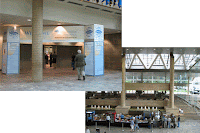 This is Whitman’s second time running this show and their mark was seen riding down the escalator when I noticed that the food court was moved. Rather than being outside the door, the service area was moved to the front lobby at the foot of the escalator. The tables were moved out closer to the lobby and Whitman placed convention-style booths for registration. Also, the entrance had a new canopy announcing the show. It looked more professional than in the past.
This is Whitman’s second time running this show and their mark was seen riding down the escalator when I noticed that the food court was moved. Rather than being outside the door, the service area was moved to the front lobby at the foot of the escalator. The tables were moved out closer to the lobby and Whitman placed convention-style booths for registration. Also, the entrance had a new canopy announcing the show. It looked more professional than in the past.
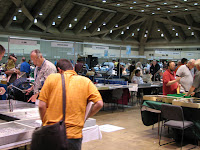 It is still an awe inspiring experience to walk into the hall and see wall-to-wall dealer tables. Adding to the depth of vision was the framing that Whitman used during the last show behind the tables to allow dealers to hang banners. As I began to walk to the left side of Hall A, I noticed that Whitman placed stickers on the floor to mark the row numbers. Looking up, on the columns, they also placed numbered signs showing row numbers and the table number group. The best way I can describe this is that the numbers resemble address numbers on street signs. It is a small touch, but when looking for a specific dealer it really helps.
It is still an awe inspiring experience to walk into the hall and see wall-to-wall dealer tables. Adding to the depth of vision was the framing that Whitman used during the last show behind the tables to allow dealers to hang banners. As I began to walk to the left side of Hall A, I noticed that Whitman placed stickers on the floor to mark the row numbers. Looking up, on the columns, they also placed numbered signs showing row numbers and the table number group. The best way I can describe this is that the numbers resemble address numbers on street signs. It is a small touch, but when looking for a specific dealer it really helps.
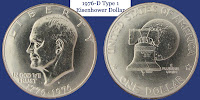
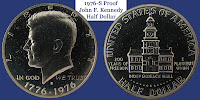 I saw a number of dealers I have bought from and spoken with in the past. Of note I was able to speak with Wayne Herndon, author of the last-page article in July’s Numismatist. The article is really good dry, tongue-in-cheek humor that I found fit Wayne’s personality when you talk with him. Wayne is a good guy and a very fair dealer. From Wayne, I was able to find some 1976 coins that I want to submit to NGC for the registry set. Finding really nice Eisenhower Dollars is very difficult, but Wayne had this 1976-D Type 1 Dollar that I could not pass up. Amongst the other coins I bought was a 1976-S Proof JFK Half Dollar is beautiful.
I saw a number of dealers I have bought from and spoken with in the past. Of note I was able to speak with Wayne Herndon, author of the last-page article in July’s Numismatist. The article is really good dry, tongue-in-cheek humor that I found fit Wayne’s personality when you talk with him. Wayne is a good guy and a very fair dealer. From Wayne, I was able to find some 1976 coins that I want to submit to NGC for the registry set. Finding really nice Eisenhower Dollars is very difficult, but Wayne had this 1976-D Type 1 Dollar that I could not pass up. Amongst the other coins I bought was a 1976-S Proof JFK Half Dollar is beautiful.
Watch out NGC, these coins (and other coins) will be sent this week!
One thing I noticed was that there was a lot of table sharing. While this is a common practice with small dealers, there were some higher volume dealers sharing tables, especially on the corners. For the buyer, this meant that there were more options. I was able to pickup some nice items while junk box diving for resale that I will be posting on eBay soon. Yes, there were some nice items in many of the junk boxes which was surprising.
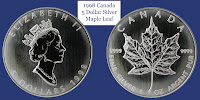 I also had taken the opportunity to try to complete my set of Silver Maple Leaf coins. I was able to find a 1989, 1992, 1996, and 1998. All I am missing from the set is 1990 and 2007. I forgot about the 2007 and did not buy one at the show. All are beautiful coins, but the 1998 is the best. Images of these coins are difficult, but I tried so I can show off their beauty.
I also had taken the opportunity to try to complete my set of Silver Maple Leaf coins. I was able to find a 1989, 1992, 1996, and 1998. All I am missing from the set is 1990 and 2007. I forgot about the 2007 and did not buy one at the show. All are beautiful coins, but the 1998 is the best. Images of these coins are difficult, but I tried so I can show off their beauty.
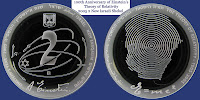 As I complete many of my United States sets, I am looking for other areas to explore. One area of interest is the currency of Israel. Coins are interesting, but the Israeli paper is beautiful with nice historical images. But first, I wanted the 2005 Theory of Relativity Commemorative Proof. I purchased a beautiful proof coin from noted dealer in Israeli Numismatics, J.J. van Grover. Van Grover is also the Vice President of the American Israel Numismatic Association, an organization which I recently joined, and we had a chance to talk about AINA and other Israeli issues. But the coin is beautiful whose image cannot do it justice.
As I complete many of my United States sets, I am looking for other areas to explore. One area of interest is the currency of Israel. Coins are interesting, but the Israeli paper is beautiful with nice historical images. But first, I wanted the 2005 Theory of Relativity Commemorative Proof. I purchased a beautiful proof coin from noted dealer in Israeli Numismatics, J.J. van Grover. Van Grover is also the Vice President of the American Israel Numismatic Association, an organization which I recently joined, and we had a chance to talk about AINA and other Israeli issues. But the coin is beautiful whose image cannot do it justice.
I did buy some Israeli paper money. These two notes are from the Fourth Series Pounds dated 1973 but issued in 1975. These notes were demonetized in 1983.
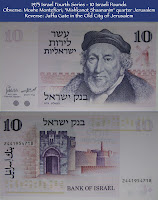

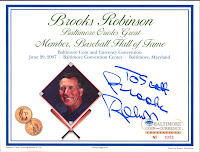 Before going through the rest of the show floor, it was time to take a pause to do something non-numismatic. Appearing at the show was Baltimore Orioles Great and Member of the Baseball Hall of Fame, Brooks Robinson. Robinson is a very gracious gentleman whose current wrist injury he blames on old age. At 70, he may not be able to defend the hot corner but he is not ready for the home either. I did stand on line for his autograph and have my picture taken. Even though my Mets beat his Orioles in 1969, I cannot deny that he was a great player and a classy person. It was a joy to meet him.
Before going through the rest of the show floor, it was time to take a pause to do something non-numismatic. Appearing at the show was Baltimore Orioles Great and Member of the Baseball Hall of Fame, Brooks Robinson. Robinson is a very gracious gentleman whose current wrist injury he blames on old age. At 70, he may not be able to defend the hot corner but he is not ready for the home either. I did stand on line for his autograph and have my picture taken. Even though my Mets beat his Orioles in 1969, I cannot deny that he was a great player and a classy person. It was a joy to meet him.
 Before returning to the bourse floor, I stopped at the nearby Whitman booth. During registration, we were given a coupon for a free copy to The Expert’s Guide to Collecting & Investing in Rare Coins, the latest tome from Q. David Bowers, with a $25 purchase. I almost walked away from the booth before noticing Whitman was selling something that was not numismatic or philatelic related. Whitman now creates something called Football Vault Books. With the publisher from the south, it is not surprising that the series started to cover the Southeastern Conference. When I found the University of Georgia Vault Book I decided to use my coupon after buying the book. The Vault Book is fantastic! It has the history and reproduction of memorabilia from the era being discussed. Ok… back to the coins.
Before returning to the bourse floor, I stopped at the nearby Whitman booth. During registration, we were given a coupon for a free copy to The Expert’s Guide to Collecting & Investing in Rare Coins, the latest tome from Q. David Bowers, with a $25 purchase. I almost walked away from the booth before noticing Whitman was selling something that was not numismatic or philatelic related. Whitman now creates something called Football Vault Books. With the publisher from the south, it is not surprising that the series started to cover the Southeastern Conference. When I found the University of Georgia Vault Book I decided to use my coupon after buying the book. The Vault Book is fantastic! It has the history and reproduction of memorabilia from the era being discussed. Ok… back to the coins.
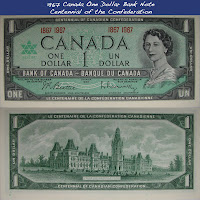 This time, the foreign section was smaller than usual. I was looking for some Canadian coins but was a little disappointed at the selection and the lack of dealers with good Canadian inventory. Rather than walk away empty handed, I bought a 1967 Centennial of the Confederation One Dollar note. It is a crisp, uncirculated note that has a look very reminiscent of the formal aspects of the 1960’s.
This time, the foreign section was smaller than usual. I was looking for some Canadian coins but was a little disappointed at the selection and the lack of dealers with good Canadian inventory. Rather than walk away empty handed, I bought a 1967 Centennial of the Confederation One Dollar note. It is a crisp, uncirculated note that has a look very reminiscent of the formal aspects of the 1960’s.
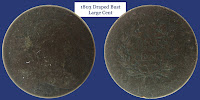 As the day was winding down, I needed to buy something old. Somebody had to have something not that expensive but old and fun. I happened upon the table for The Butternut Company out of Clifton, Virginia. Butternut has a nice business of Civil War memorabilia along with the coins. But the had a junk box of well worn large and half cents. Ah ha! Something old! So I searched the small box looking for something with a readable date. In the box I found an 1803 Large Cent that satisfied my old and fun criteria. It is 204 years old and is just loaded with history.
As the day was winding down, I needed to buy something old. Somebody had to have something not that expensive but old and fun. I happened upon the table for The Butternut Company out of Clifton, Virginia. Butternut has a nice business of Civil War memorabilia along with the coins. But the had a junk box of well worn large and half cents. Ah ha! Something old! So I searched the small box looking for something with a readable date. In the box I found an 1803 Large Cent that satisfied my old and fun criteria. It is 204 years old and is just loaded with history.
As I left with ten minutes to closing, dealers were already closing down and vacating. I walked through the Sheraton, purchased a beverage and candy bar from the hotel shop, and retrieved my car from their lot. I left driving around traffic on their way to an Orioles game and found my way to I-395 to head back to the Washington, DC area. During the trip I called my wife to discuss dinner plans and made good time going south on I-95 to the Capital Beltway. I picked up something for dinner and headed home. After being happily greeted by Boomer, I cleaned up and served dinner while telling my wife about the fun I had. Show-and-tell occurred before desert.
In all, it was a wonderful day and a wonderful show.
Click on any image to enlarge. Vault Book cover from Whitman Publishing.
May 20, 2007 | coins, currency, fun, history
Yes, I know the John Adams Dollar was released this week. But Real Life™ got in the way and I was not able to go downtown Washington to buy first day of issue coins. For now, I will by pass talk of the Adams Dollar in favor of some fun.
The Futures Channel is an online video service that creates multimedia content to bridge the gap between the Real World™ and the subjects students are learning in school. It is a great idea with interesting results. Two videos that I thought would be of interest to numismatists, collectors, and hobbyists are First American Coins and Printing Money.
Although First American Coins does not mention where it was taped, there are mentions of the ANA World’s Fair of Money that was held in Denver the Summer of 2006. Amongst the video’s vignettes is a picture and discussion of the Brasher Doubloon as the first US gold coin and the half dismes as the first silver coins made from George and Martha Washington’s silver.
Printing Money also has images from the ANA World’s Fair of Money in 2006, but also has what appears to be stock footage that is rumored to have been provided by the Bureau of Engraving and Printing. Still, it is an interesting video.
Both videos make an attempt to tie the content back to mathematics in order to provide benefits for the students. For the rest of us, it just interesting.
Mar 4, 2007 | counterfeit, currency, tokens
News reports out of New York City and Nassau County on Long Island reports that a 49 year old suspect has been passing bogus $50 and $100 bills in the area. Another suspect was arrested in Manhattan. Although suspects have been arrested, the New York Field Office of the US Secret Service is warning those in the metropolitan New York area that there may be more suspects and phony money in circulation. Secret Service has issued fliers showing the public what the fake bills look like.
- Click here to view the flier describing the counterfeit $100 bill
- Click here to view the flier describing the counterfeit $50 bill
In an unrelated story, a Buffalo man plead guilty to charges for his role in transmitting fake Toronto Transit Tokens into Canada. Tokens were made at an American token manufacturer and were to be sold in multiple shipments to Canadian dealers. These tokens have a face value of C$2.50. The real tokens were minted by the Royal Canadian Mint.
The Toronto Transit Commission (TTC) estimates that 40 percent of its tokens were counterfeit. To prevent further counterfeiting, TTC introduce a two-toned token and stopped accepting the old tokens on February 1.

















